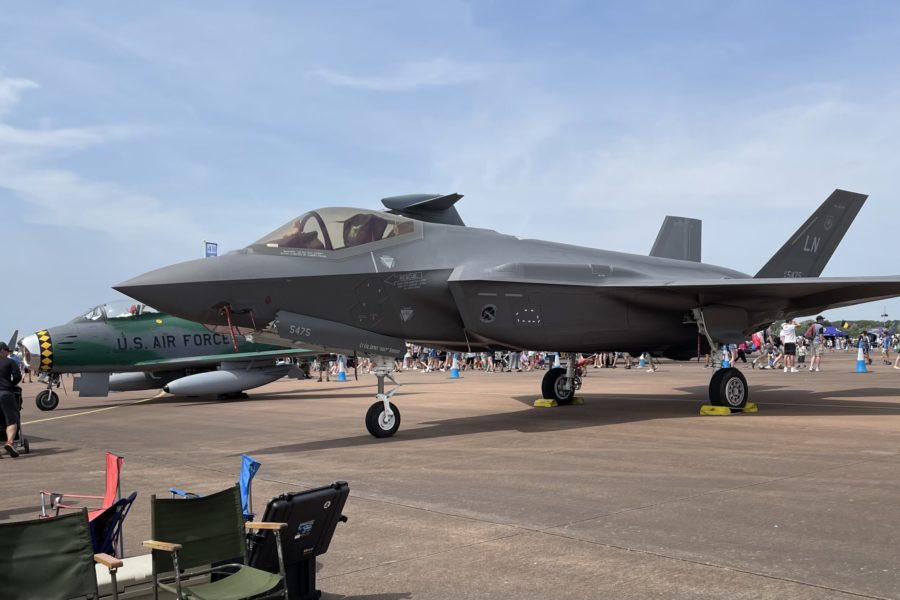FAIRFORD, U.K.—At a NATO summit in June, President Joe Biden highlighted the two F-35 squadrons the U.S. is placing in the United Kingdom as part of his administration’s response to Russia’s invasion of Ukraine.
But once those two squadrons, both stationed at RAF Lakenheath, are built out, the U.S. has no immediate plans to further expand its permanent fleet of F-35 fighters in Europe, the new commander of U.S. Air Forces in Europe said.
At the same time, Gen. James B. Hecker said in an exclusive interview with Air Force Magazine at the Royal International Air Tattoo, the number of American fifth-generation fighters on the continent will be bolstered.
“Right now, we have, I think it’s like 11 aircraft [at Lakenheath], so it’s just the one F-35 squadron that’s kind of stood up, and they’re half-filled,” Hecker said July 17. “They’re going to eventually have … by 2024 two different squadrons of F-35s there for a total of 52 aircraft, F-35s. We’ll still have the Strike Eagles there, so another two squadrons of [F-15E] Strike Eagles. Right now, that is the limit of the F-35s that we’re going to have in Europe from the United States.”
In addition to those Lakenheath fighters, though, Hecker said USAFE will continue to get help from F-35s stationed in the U.S.
“We have some at Hill Air Force Base. We have some at Vermont. Vermont, right now, coincidentally, has 12 F-35s over here in Europe,” Hecker said. “So we can get them here in a hurry, pretty quickly if we need to build up.”
Those F-35s from the Vermont Air National Guard arrived in early May at Spangdahlem Air Base, Germany, replacing F-35s from the 34th Fighter Squadron at Hill Air Force Base, Utah, which had arrived in February. While in Europe, the Vermont fighters have assisted with NATO’s air policing mission, conducting missions over Latvia, Estonia, and Lithuania, among others.
When they leave, Hecker indicated they’ll be succeeded by still more fifth-gen fighters.
“We’re bringing over F-22s … that are going to be coming over shortly, within a month, and they’ll spend four or five months over here,” Hecker said. “So we’re going to constantly cycle in fifth-generation in addition to what will eventually be two permanent squadrons at Lakenheath. So we’ll be cycling it in here in the meantime.”
That approach of swapping in and out extra fighters will last for around a year, Hecker said, as part of a broader Pentagon strategy to mainly rely on rotational forces to bolster the U.S. presence in Europe.
“This is not strictly just to the Air Force, but this is what the Army is going to be doing as well … So what we’re going to do is just kind of have six, 12 kinds of airplanes that will come in here for four months, and we’ll do that for about a year or so, in addition with all the permanent aircraft that we have stationed here,” Hecker said. “And that will increase our presence here, and then we’ll have to readjust and see what this thing looks like a year from now, and then we can adjust as necessary.”
There are several reasons why more permanently based F-35s won’t happen right now, Hecker added.
“We can’t just permanently bring a bunch of aircraft over here. We have about half the number of fighter squadrons that we did 30-some-odd years ago. So we just don’t have enough where we can just permanently put a bunch here,” said Hecker. “Likewise, the pacing threat is China. So being a team player, even though I’m [USAFE-AFAFRICA] now, I realize the National Defense Strategy says we need to keep our eyes on China as well. So we can’t just be asking for everything here because we also have to make sure we’re deterring China in the Pacific.”
But while the number of permanently based U.S. F-35s will stay at the 52 aircraft spread among two squadrons, the total number of F-35s across Europe is slated to grow substantially as more and more partner nations indicate they’ll buy the Joint Strike Fighter.
In recent months, Germany, Greece, Finland, and Switzerland have all indicated plans to buy F-35s, on top of nations like the U.K., Belgium, Denmark, Italy, the Netherlands, Norway, and Poland that have already signed deals to do so.
In 2021, former head of U.S. European Command and NATO Supreme Allied Commander in Europe Gen. Tod D. Wolters predicted that by 2030, there would be 450 F-35s spread across Europe. A year later, he bumped up that prediction to 550.
Now, Hecker is predicting even more, albeit by a later date.
“Right now, we have six countries that have the F-35 over here and have 120ish F-35s, which is very capable,” Hecker said. “But if you look down the road, by about the 2040 timeframe, we’re going to have over 600 F-35s here, and that will be a big, big deterrent against anybody who wants to take on NATO.”
Such a future will obviously increase interoperability, Hecker said. But the allies will still need to train and practice things such as tactics, he said—and they will need to work alongside fourth-generation aircraft, too.
“Not everybody is going to have F-35s. … Almost all countries will still have fourth generation,” Hecker said. “So we need to work on, how do we integrate fifth-generation with fourth-generation? Because once the mass goes up, we’re not going to have enough strictly fifth-gen that that’s all we use,” Hecker said. “So we need to use the F-35 to kind of knock down the door, gain some air superiority where we can get the fourth-generation in to finish and complete the job they can do once we get air superiority.”
